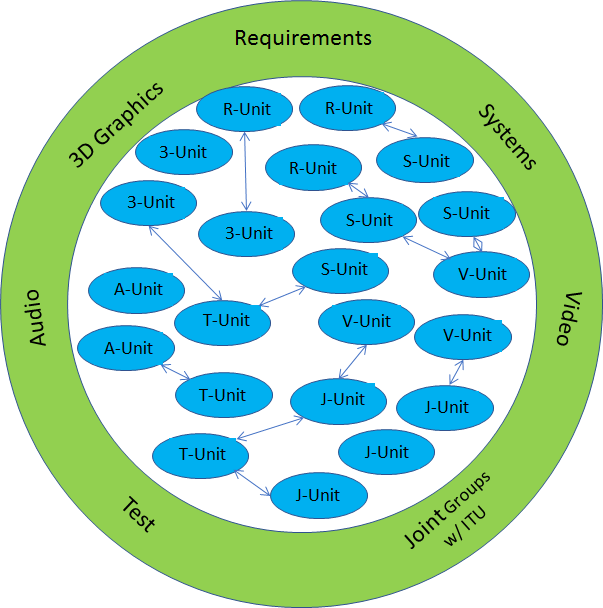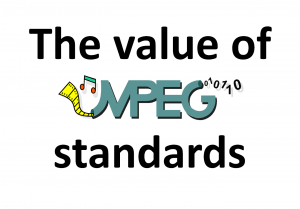Introduction
In Einige Gespenster gehen um in der Welt – die Gespenster der Zauberlehrlinge I described the case of an apprentice who operates in an environment that practices some mysterious arts (that in the past could have been called sorcery). Soon the apprentice wakes up at the importance of what he is learning/doing and thinks he has learned enough to go his own way.
The reality is that the apprentice has not learnt yet the art not because he has not studied and practiced it diligently and for enough time. He has not learnt it because no one can say “I know the art”. One can say to have practiced the art for a certain time, to have got that much experience or to have had this and that success (better not talk of failures or, better, to talk of successes after failures). The best one can say is that successes were the result of a time-tested teamwork.
Nothing fits more this description than the organisation of human work and this article will deal with how MPEG has developed a non-apprentice based organisation.
Work organisation across the millennia
Thousands of years ago (even rather recently) there was slave labour. By “owning the humans” people assumed they could impose any task on them (until a Spartacus came in, I mean).
More advanced than slavery is hired labour, because humans are not owned, you pay them and they do work for you. You can do what you want within a contract but only up to a point (much lower than with slave labour). If you cross a threshold you have to deal with unions or simply with workers leaving for another job and employer.
Fortunately, there have been many innovations over and beyond this archaic form of relationship. One case is when you have a work force hired to do intellectual work, such as research on new technologies. Managing the work force is more complicated, but there is an unbeatable tool: the promise to share the revenues of any invention that the intellectual worker makes.
Here, too, there are many variations to bind researcher and employer, to the advantage of both.
The MPEG context is quite different
Apart from not being a company, MPEG has a radically different organisation than any of those described above. In MPEG there are “workers”, but MPEG has no control of them because MPEG is not paying any salary. Someone else does. Still, MPEG has to improve the relationship between itself, the “virtual employer”, and its“workers”, if it is not to produce dull standards.
Here are some: projecting the development of a standard as a shared intellectual adventure, pursuing the goal with a combination of collective and personal advantages, promoting a sense of belonging to a great team, flashing the possibility to acquire personal fame because “we are making history here” and more.
For the adventure to be possible, however, MPEG has to entice two types of “worker”. One is the researcher who knows things and the other the employer who pays the salary. Both have to buy into the adventure.
This is not the end of the story because MPEG must also convince users of the standard that it will make sense for their industrial plans. By providing requirements, the users of the standard establish client-supplier relationship with MPEG.
Thirty years ago, matters were much simpler because the guy who paid the salary was regularly the same guy who used the standard. Today things are more complicated because the guy who pays the salary of the “worker” may very well not have any relationship with the guy who uses the standard, because their role may stop at providing the technologies that are used in the standards.
Organising the work in MPEG
So far so good. This is the evolution of an established business that MPEG brought about. This evolution, however, was accompanied by substantial changes in the object of work. In MPEG-1 and MPEG-2, audio, video, 3D graphics and systems were rather well delimited areas (not really, but compared with today, certainly so). Starting with MPEG-4, however, the different pieces of MPEG business got increasingly entangled.
If MPEG had been a company, it could have launched a series of restructurings, a favourites activity by many companies who think that a restructuring shows how their organisation is flexible. They can think and say that because they are not aware of the human costs of such reorganisations.
I said that MPEG is not a company and MPEG “workers” are not really workers but researchers rented out by their employers, or self-styled entrepreneurs, or students working on a great new idea etc. In any case, MPEG “workers” are intellectually highly prominent individuals.
When it started its work on video coding for interactive applications on digital media, MPEG did not have particularly innovative organisational ideas. Little by little it extended the scope of its work to other areas that were required to provided complete audio-visual solution.
MPEG ended up with building a peculiar competence centre-based organisation by reacting to the changing conditions at each step of its evolution. The organisation has gradually morphed (see here for the full history). Today the competence centres are: Requirements, Systems, Video, Video collaborations with ITU-T, Audio, 3D Graphics and Tests.
The innovative parts of the MPEG organisation are the units, formed inside each of these competence centres. They can have one of these two main goals: to address specific items that are required to develop one or more standards and to investigate related issues that may not be directly related to the standard. This is the mix of two developments: technologies for the standards and know-how for future standards, of which MPEG is proud.
Units may be temporary and sometimes may be long-lived. All units are formed with a natural leader, often as a result of an ad hoc group, whose creation may have been triggered by a proposal.
A graphical description of the MPEG organisation is provided by Figure 1

Figure 1 – The flat MPEG organisation
The units working for standards under development produce outputs which are integrated by the relevant competence centre plenaries and implemented by the editors with the assistance of the experts who have developed component technologies. The activity of the units of the joint groups with ITU-T are limited to the development of specific standards. Therefore, they do not have units working on explorations if not directly finalised to providing answers to open issues in their standards under development.
This is MPEG’s modus operandi that some (outside MPEG) think is the MPEG process described in How does MPEG actually work?. Nothing is farther from truth. MPEG’s modus operandi is the informal but effective organisation that permeates the MPEG work and allows interactions to happen when they are needed by those who need them at the time they need them. It is a system that allows MPEG to get the most out of the individual initiative, combining the need to satisfy industry needs now and and the need to create the right conditions for future standards tomorrow.
Proposing, as mentioned in Einige Gespenster gehen um in der Welt – die Gespenster der Zauberlehrlinge, to create a group that merges the Video and 3D Graphics competence centres based on a a hierarchical structure with substructures is prehistory of work organisation – fortunately not stretching back to slave labour. This is something that today would not even be considered in the organisation of a normal company, to say nothing of the organisation of a peculiar entity such as MPEG.
Units are highly mobile. They interact with other groups either because an issue is identified by the competence centre chairs, or by the competence centre plenaries or by initiative of the unit itself. Interaction can also be between groups or between units in different groups.
The number of units at any given time is rather large, exceeding 20 or even 30. Therefore the IT support system described in Digging deeper in the MPEG work and that is reproduced below helps MPEG members to keep up with the dynamics of all these interactions by providing information on what is being discussed where and when.

Figure 2 – How MPEG people know what happens where
Conclusions
A good example of how MPEG’s modus operandi can pursue its primary goal of producing standards, while at the same time keeping abreast of what comes next is the common layer shared by 3DoF+ and 3DG. This is something that MPEG thought conceptually existed and could have been designed in a top-down fashion. We did not do it because MPEG is not a not-for-profit organisation that pursues the goal of furthering the understanding of science. MPEG is a not-for-profit organisation developing standard while at the same time preparing the know-how for the next challenges. By not by imposing a vision of the future but doing the work today and investigating the next steps, we get ready to respond to future requests from the industry.
What will be the nest steps of 3DoF+ and 3DG convergence is another story for another article.
Posts in this thread
- Developing standards while preparing the future
- No one is perfect, but some are more accomplished than others
- Einige Gespenster gehen um in der Welt – die Gespenster der Zauberlehrlinge
- Does success breed success?
- Dot the i’s and cross the t’s
- The MPEG frontier
- Tranquil 7+ days of hard work
- Hamlet in Gothenburg: one or two ad hoc groups?
- The Mule, Foundation and MPEG
- Can we improve MPEG standards’ success rate?
- Which future for MPEG?
- Why MPEG is part of ISO/IEC
- The discontinuity of digital technologies
- The impact of MPEG standards
- Still more to say about MPEG standards
- The MPEG work plan (March 2019)
- MPEG and ISO
- Data compression in MPEG
- More video with more features
- Matching technology supply with demand
- What would MPEG be without Systems?
- MPEG: what it did, is doing, will do
- The MPEG drive to immersive visual experiences
- There is more to say about MPEG standards
- Moving intelligence around
- More standards – more successes – more failures
- Thirty years of audio coding and counting
- Is there a logic in MPEG standards?
- Forty years of video coding and counting
- The MPEG ecosystem
- Why is MPEG successful?
- MPEG can also be green
- The life of an MPEG standard
- Genome is digital, and can be compressed
- Compression standards and quality go hand in hand
- Digging deeper in the MPEG work
- MPEG communicates
- How does MPEG actually work?
- Life inside MPEG
- Data Compression Technologies – A FAQ
- It worked twice and will work again
- Compression standards for the data industries
- 30 years of MPEG, and counting?
- The MPEG machine is ready to start (again)
- IP counting or revenue counting?
- Business model based ISO/IEC standards
- Can MPEG overcome its Video “crisis”?
- A crisis, the causes and a solution
- Compression – the technology for the digital age

